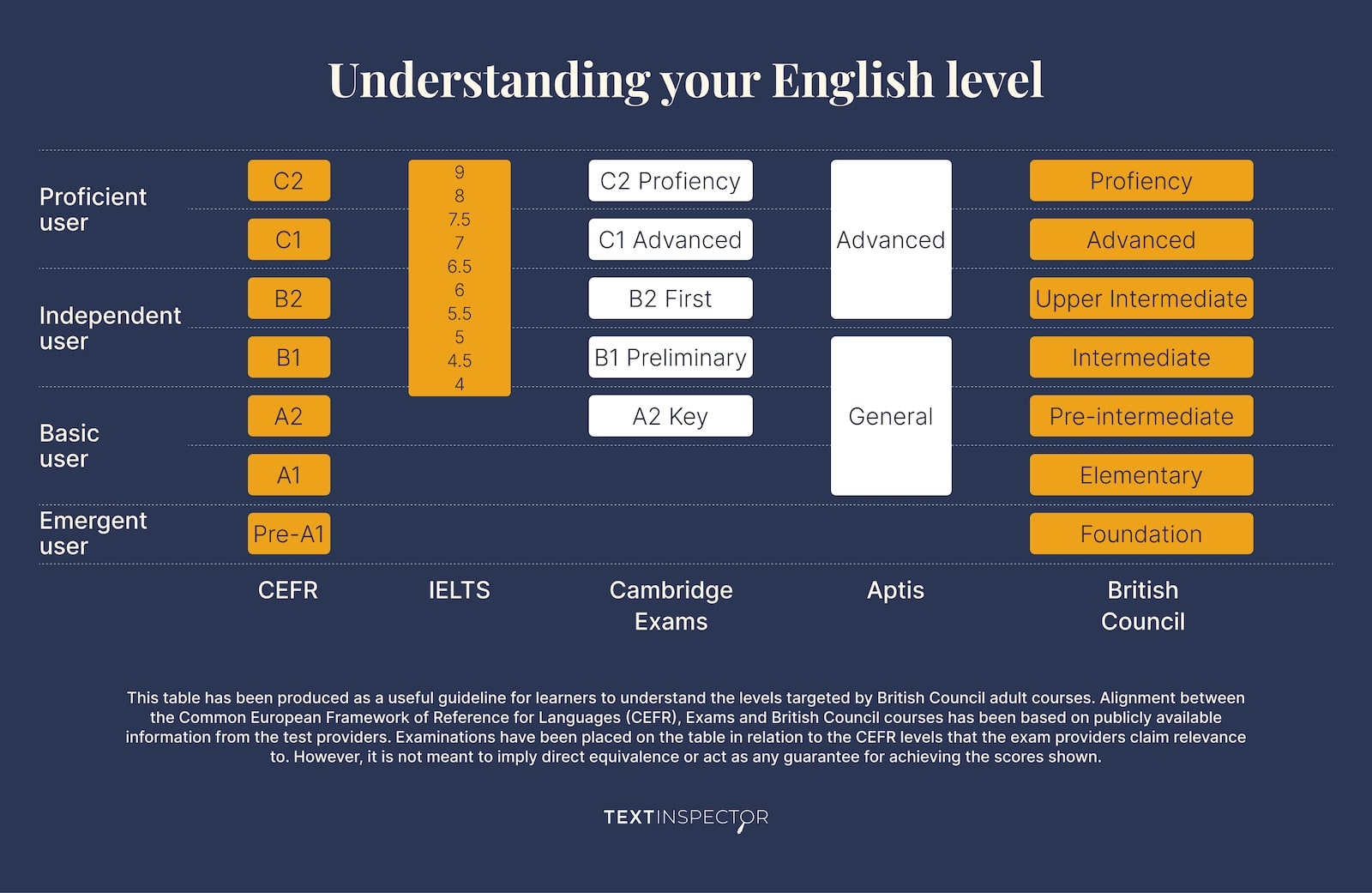
The Common European Framework of Reference for Languages (CEFR) is essential for language learning, providing a standardized way to describe language proficiency.
This guide answers your most pressing questions about CEFR levels, especially relevant for English learners and educators.
What are CEFR Levels A1, A2, B1, B2, C1, C2?
The CEFR defines six levels of language proficiency:
C2 (Mastery or Proficiency): Can understand with ease virtually everything heard or read, express themselves spontaneously, very fluently, and precisely, differentiating finer shades of meaning even in the most complex situations.
A1 (Breakthrough or Beginner): Can understand and use very basic phrases, introduce themselves, and ask simple questions.
A2 (Waystage or Elementary): Can understand sentences and frequently used expressions, communicate in simple tasks, and describe aspects of their background.
B1 (Threshold or Intermediate): Can understand the main points of clear standard input, deal with most situations likely to arise while travelling, and produce simple connected text on familiar topics.
B2 (Vantage or Upper Intermediate): Can understand the main ideas of complex text, interact with a degree of fluency, and produce clear, detailed text on a wide range of subjects.
C1 (Effective Operational Proficiency or Advanced): Can understand a wide range of demanding, longer texts, express themselves fluently and spontaneously, and use language flexibly and effectively.
How Do I Know My CEFR Level?
Your CEFR level can be determined through various assessment methods, including official tests like Cambridge English exams, or through self-assessment grids provided by the Council of Europe.
It’s crucial to use reliable testing within the UK, or in whichever country you are based, to ensure accurate results. Tools like Text Inspector can also provide lexical analysis, offering insights into the complexity of language use.
Does CEFR Level Matter?
Yes, CEFR levels are significant in academic and professional contexts worldwide. They provide a clear framework for language learning standards and are widely recognized by employers and educational institutions.
CEFR levels are particularly important for international communication and mobility.
Is CEFR Only for English?
No, CEFR is a framework for all languages. It’s used across Europe and beyond, for various language education and assessment programs.
Are Native Speakers a CEFR Level C1 or C2?
This is a common misconception. While native speakers have a high degree of language fluency, their proficiency is distinct from CEFR levels. Even native speakers may not achieve C2 in formal language assessments, as these tests evaluate specific linguistic skills.
What Does CEFR Level B2 Mean?
CEFR Level B2 signifies upper-intermediate proficiency. At B2, learners can understand complex texts, interact fluently, and produce detailed writing on various subjects. For example, they can participate in detailed discussions and write clear reports.
What Ages Do the CEFR Language Levels Correspond To?
CEFR levels don’t directly correlate to specific ages since language acquisition is influenced by many factors. However, a general guidance to relate CEFR levels with average ages can be:
- Early Stages (A1-A2): These levels are often achieved during primary or early secondary school years, but this varies greatly.
- Intermediate Stages (B1-B2): Many secondary school students aim for these levels, with B2 being a common goal for upper secondary education.
- Advanced Stages (C1-C2): These levels typically require more extensive study and are often reached during or after university-level education or through significant immersion experiences.
What is the CEFR Level in IELTS?
IELTS scores correlate with CEFR levels. For example, an IELTS score of 6.5-7.0 typically corresponds to CEFR Level B2. Here’s a general conversion:
- IELTS 4.0-5.0: B1 CEFR
- IELTS 5.5-6.5: B2 CEFR
- IELTS 7.0-8.0: C1 CEFR
- IELTS 8.5-9.0: C2 CEFR
How Many Words Should You Know for Each CEFR Level?
Vocabulary size relates to CEFR levels. While exact numbers vary, approximate guidelines exist:
- A1-A2: 1,000-2,000 words
- B1-B2: 3,000-6,000 words
- C1-C2: 8,000+ words
Vocabulary depth and usage are equally important.
What is the US Equivalent of CEFR?
The US lacks a direct CEFR equivalent. However, ACTFL (American Council on the Teaching of Foreign Languages) proficiency guidelines share similarities.
While ACTFL uses different descriptors and levels (Novice, Intermediate, Advanced, Superior, Distinguished), both frameworks aim to describe language proficiency.
It’s important to note that the two systems are not perfectly interchangeable, but they both serve to assess and define language skills.
Is Duolingo Equivalent to CEFR?
No, Duolingo is a language learning tool, not a formal assessment. While Duolingo aims to align courses with CEFR, its levels are not directly equivalent to official CEFR certifications.
Duolingo’s focus is on language acquisition, while CEFR provides a benchmark for language proficiency. Therefore, Duolingo and CEFR serve different but potentially complementary roles in language learning.
Is TOEFL Equivalent to CEFR?
While TOEFL and CEFR have different scoring systems, there are established conversions, and TOEFL scores can be correlated with CEFR levels, similar to IELTS.
For example, a high score on the TOEFL iBT (95-120) generally aligns with CEFR Level C1.
These conversions are useful for institutions and individuals to compare and understand language qualifications.
What is a Good CEFR Level for a 15-Year-Old?
A “good” CEFR level for a 15-year-old varies based on many factors. However, for a 15-year-old native speaker, a B1 or B2 level is often considered a good target, however he would typically demonstrate C1 or C2 level abilities, depending on their educational context and language exposure, but individual progress and the specific learning context are important.
For non-native English speakers, a B1 (Intermediate) or B2 (Upper Intermediate) level is generally a strong and achievable target for a 15-year-old, again, depending on their learning context and exposure.
To delve deeper into language analysis and explore related topics, we encourage you to visit the Text Inspector Blog.
You can also use the Text Inspector tool to measure the CEFR level of any text, gaining further insights into its complexity and suitability.
Share
Related Posts

What Is The CEFR Level of Harry Potter? (Part 2)
19 May, 2025
In our previous article, we explored the CEFR levels of the first three Harry Potter […]
Read More ->
CEFR Levels Explained: Your Comprehensive FAQ Guide
27 June, 2025
The Common European Framework of Reference for Languages (CEFR) is essential for language learning, providing […]
Read More ->
What Is The CEFR Level of Harry Potter? (Part 1)
12 May, 2025
The Harry Potter series is not only a global literary success but also a valuable […]
Read More ->